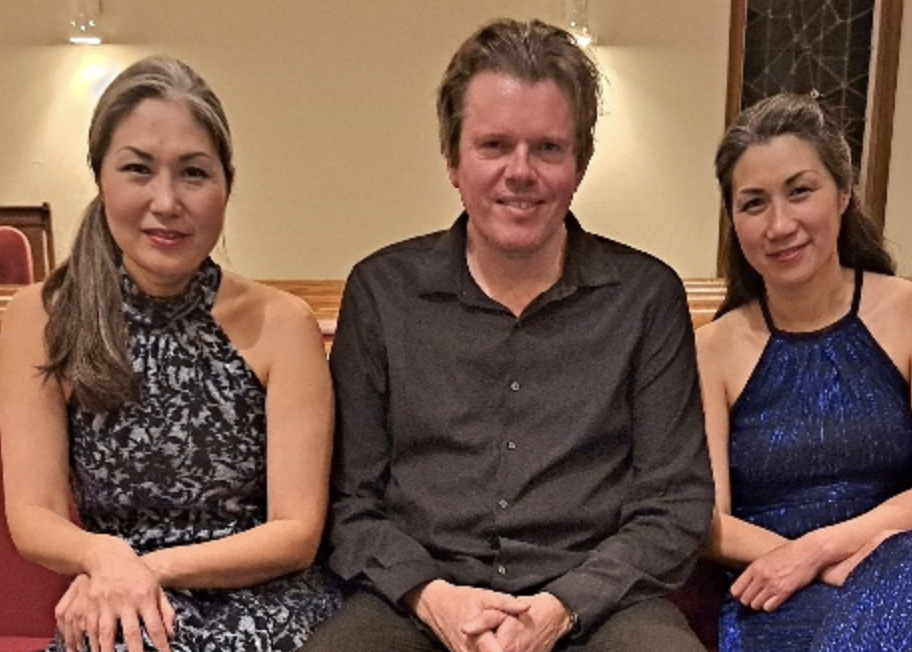|
Symphony
SRS SEASON ENDS WITH RESOUNDING TA-TA-TA-BANG
by Terry McNeill
Sunday, June 1, 2025
Symphony
YOUTHFUL VIRTUOSITY ON DISPLAY AT USO'S MAY CONCERTS
by Peter Lert
Saturday, May 17, 2025
Symphony
MYSTICAL PLANETS AND LIVELY GERSHWIN ORTIZ AT FINAL SRS CONCERT
by Peter Lert
Sunday, May 4, 2025
Symphony
VSO'S CONCERT MUSIC OF TIME, MUSIC OF PLACE
by Peter Lert
Sunday, April 27, 2025
Choral and Vocal
VOCAL ELEGANCE AND FIRE AT THE 222'S RECITAL APRIL 26
by Pamela Hicks Gailey
Saturday, April 26, 2025
CANTIAMO SONOMA SINGS AN INSPIRED GOOD FRIDAY MOZART REQUIEM CONCERT
by Pamela Hicks Gailey
Friday, April 18, 2025
DRAMATIC SHOSTAKOVICH SYMPHONY CLOSES PHILHARMONIC'S 25TH SEASON
by Terry McNeill
Sunday, April 13, 2025
LARGE COLLEGE OF MARIN AUDIENCE GREETS STOPHER ARTISTRY
by Terry McNeill
Saturday, April 5, 2025
Chamber
FRISSON DELIVERS SHIVERS OF DELIGHT
by Abby Wasserman
Sunday, March 30, 2025
OLD AND MOSTLY NEW IN SRS MARCH CONCERT IN WEILL
by Peter Lert
Saturday, March 22, 2025
|
 |
 Trio Con Brio Feb. 12 (A. Wasserman Photo) |
A TRIO WITH BRIO AT CHAMBER MUSIC MARIN!
by Abby Wasserman
Sunday, February 12, 2023
Per Nørgård scored one of my favorite films, “Babette’s Feast,” but on Feb. 12 I got to know Nørgård better.
In a Chamber Music Marin concert the Trio con Brio Copenhagen played the Danish composer’s mesmerizing 1973 composition Spell, 18 minutes of an astral journey that could have been modeled on the interior of an atom as it was conceived by Nørgård’s countryman, the physicist Niels Bohr, one hundred years ago.
Spell, originally written for clarinet, piano and cello, was rewritten by Nørgård for violin, piano and cello, and the combination is serendipitous. Starting with whispery, light strikes, drips, and plucks that expanded in scope and grew in volume, the music moved through changing moods. Tiny motifs repeated and were echoed and disappeared only to reappear in new patterns. A few times it seemed the musicians were improvising and perhaps they were, animated by a secret code within a set pattern.
Based in Denmark, Trio con Brio Copenhagen consists of two “musical pairs”: Violinist Soo-Jin Hong and cellist Soo-Kyung Hong are sisters; Soo-Kyung is married to pianist Jens Elvekjaer. They formed the trio in 1999.
Ravel’s shimmering Piano Trio in A minor came next on the program. Ravel wrote it in 1914, and as Mr. Elvekjaer mentioned in remarks from the stage, Ravel wrote only one each in a number of major musical forms, and this was his only trio. Precise and exacting, his scores are full of tiny markings, giving musicians very specific instructions how to play each complex, tightly textured measure. It is a wonder that this scrupulous craftsmanship created music that soars into deep space. By making use of the highest and lowest ranges of the three instruments, he created a unique orchestral sound in the Trio, sometimes spacing the violin and cello two octaves apart with the piano part in the middle, in a way that balanced the voices while bringing out each distinct voice. Trio con Brio handled all of these intricacies beautifully. The weave of the piece contains many tiny threads, making a revelatory listening experience.
The group has long performed this Trio, but they played with total freshness, as though discovering new features in a familiar partner. Their connection with one another was lovely to see, especially the eye contact between the cellist and violinist, who have been playing together since they were children.
The Modéré first movement contains Basque folk melodies, and opened with a sequence of single notes on the piano, like stepping stones in a stream. The piano line was joined by the cello and then the violin in luminous harmonies. The violin stated the second motif, and when it reached its highest note, the cello came in from below. And so it went, each section a tonal revelation.
The second movement (Pantoum) refers to oral poetry of Malay origin that influenced certain French poets like Verlaine, where repeating lines change meaning throughout the poem. The Passacaille third movement employs the pentatonic scale, and the performance colored its theme and 10 variations with arpeggios, pizzicato, unison lines, slurs, trills, tremolos, cascading runs, all mirroring Spanish rhythms. The variations became increasingly intricate and intense before returning to the original theme and softening to silence. The finale, a rondo form, was played in a highly energetic manner and mostly fortisimo. The virtuosic performance was applauded with great enthusiasm.
After intermission the Trio offered an exceptional reading of Brahms’ Piano B Major Trio, Op. 8, in the 1891 revision. Brahms was 20 when he wrote the first version in 1854. Mr. Elvekjaer remarked that the revision blends the youthful energy and imagination of the young Brahms with a master’s mature skill and wisdom.
The performance was sublime. In the revision the composer retained the trio’s lyrical earlier beginning, and the pianist’s opening chords sketched out the theme with gentle beauty. The cello answered with a glorious first melody and Soo-Jin Hong’s violin playing was eloquent. Brahms largely retained his original Scherzo (Allegro molto() second movement with its polyphony and waltz rhythms. Soo-Kyung Hong’s cello playing was especially moving in the Adagio as the melodies moved between piano and strings and subsequently resolved as a cello solo.
The final movement has been described as “a musical battle between hope and despair.” It vacillates between B Major and B minor, a structural shift that resolves in B minor and that the printed program notes called “unresolved tension.”
Trio con Brio Copenhagen’s concert ended on this poignant note, with an initial audience silence that quickly erupted in cheers and a lengthy standing ovation.
|

